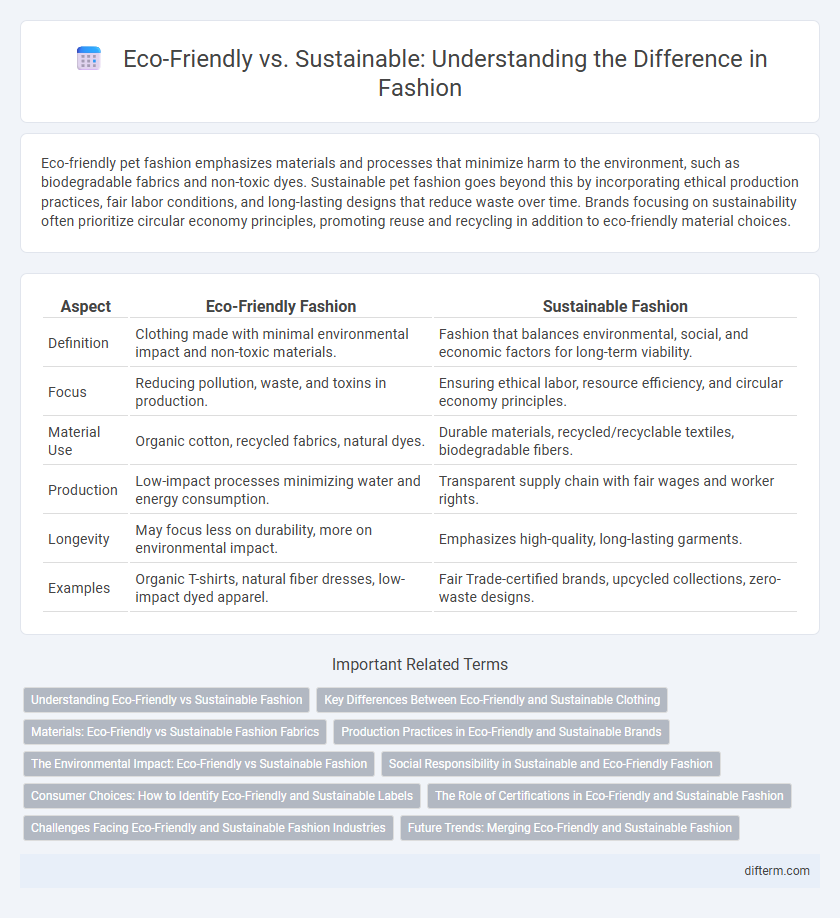Eco-friendly pet fashion emphasizes materials and processes that minimize harm to the environment, such as biodegradable fabrics and non-toxic dyes. Sustainable pet fashion goes beyond this by incorporating ethical production practices, fair labor conditions, and long-lasting designs that reduce waste over time. Brands focusing on sustainability often prioritize circular economy principles, promoting reuse and recycling in addition to eco-friendly material choices.
Table of Comparison
| Aspect | Eco-Friendly Fashion | Sustainable Fashion |
|---|---|---|
| Definition | Clothing made with minimal environmental impact and non-toxic materials. | Fashion that balances environmental, social, and economic factors for long-term viability. |
| Focus | Reducing pollution, waste, and toxins in production. | Ensuring ethical labor, resource efficiency, and circular economy principles. |
| Material Use | Organic cotton, recycled fabrics, natural dyes. | Durable materials, recycled/recyclable textiles, biodegradable fibers. |
| Production | Low-impact processes minimizing water and energy consumption. | Transparent supply chain with fair wages and worker rights. |
| Longevity | May focus less on durability, more on environmental impact. | Emphasizes high-quality, long-lasting garments. |
| Examples | Organic T-shirts, natural fiber dresses, low-impact dyed apparel. | Fair Trade-certified brands, upcycled collections, zero-waste designs. |
Understanding Eco-Friendly vs Sustainable Fashion
Eco-friendly fashion emphasizes reducing environmental impact by using materials and processes that minimize pollution and waste, such as organic cotton or recycled fabrics. Sustainable fashion encompasses a broader approach, integrating social, economic, and environmental responsibility across the entire supply chain, including fair labor practices and long-lasting garment quality. Understanding the distinction helps consumers make informed choices that support both environmental preservation and ethical production standards.
Key Differences Between Eco-Friendly and Sustainable Clothing
Eco-friendly clothing emphasizes reducing environmental harm through materials like organic cotton and low-impact dyes, focusing primarily on minimizing pollution and waste during production. Sustainable clothing encompasses a broader approach, integrating ethical labor practices, long-lasting durability, and circular economy principles alongside environmental considerations. The key difference lies in sustainability addressing the entire lifecycle and social impact, while eco-friendly targets specific environmental benefits.
Materials: Eco-Friendly vs Sustainable Fashion Fabrics
Eco-friendly fashion fabrics prioritize minimal environmental impact through renewable, biodegradable materials like organic cotton and bamboo, reducing pollution and resource consumption. Sustainable fashion fabrics emphasize long-term ecological balance by incorporating recycled fibers, durable textiles, and innovative processes that support circular economy principles. Both approaches aim to transform the industry but differ in scope, with eco-friendly focusing on immediate impact and sustainable encompassing broader lifecycle sustainability.
Production Practices in Eco-Friendly and Sustainable Brands
Eco-friendly fashion brands primarily emphasize minimizing environmental harm by using organic materials, non-toxic dyes, and low-impact manufacturing techniques to reduce pollution and waste. Sustainable brands adopt a broader approach, integrating ethical labor practices, circular economy principles, and resource-efficient production methods to ensure long-term ecological balance. Both production practices aim to lessen fashion's carbon footprint but sustainable brands encompass social responsibility alongside environmental considerations.
The Environmental Impact: Eco-Friendly vs Sustainable Fashion
Eco-friendly fashion emphasizes reducing immediate environmental harm by using non-toxic materials and minimizing waste during production. Sustainable fashion adopts a holistic approach, considering the entire lifecycle of garments, including ethical labor practices, resource regeneration, and long-term ecological balance. Both methods aim to lessen the fashion industry's carbon footprint, water consumption, and pollution but sustainable fashion ensures ongoing environmental responsibility beyond eco-friendly practices.
Social Responsibility in Sustainable and Eco-Friendly Fashion
Social responsibility in sustainable and eco-friendly fashion emphasizes ethical labor practices, fair wages, and safe working conditions across the supply chain. Brands that prioritize social responsibility actively engage in community development and transparency, fostering trust among consumers and workers alike. This commitment ensures that environmental initiatives align with human rights, creating a holistic approach to fashion sustainability.
Consumer Choices: How to Identify Eco-Friendly and Sustainable Labels
Consumers can identify eco-friendly fashion labels by looking for certifications such as Global Organic Textile Standard (GOTS), OEKO-TEX, and Bluesign, which ensure reduced environmental impact and safer chemical use. Sustainable fashion labels often emphasize transparency in supply chains, using materials like organic cotton, recycled fibers, and promoting ethical labor practices. Recognizing these certifications and brand commitments enables informed consumer choices that support environmental responsibility and social equity in the fashion industry.
The Role of Certifications in Eco-Friendly and Sustainable Fashion
Certifications such as GOTS (Global Organic Textile Standard) and OEKO-TEX play a crucial role in validating eco-friendly and sustainable fashion claims, ensuring transparency and consumer trust. These standards assess the environmental impact, chemical usage, and social responsibility of textile production, promoting accountability across the supply chain. Brands leveraging certifications demonstrate commitment to reducing carbon footprint and supporting ethical labor practices, driving industry-wide sustainability progress.
Challenges Facing Eco-Friendly and Sustainable Fashion Industries
Eco-friendly fashion faces significant challenges such as the high cost of using organic materials and limited availability of sustainable fabrics, which hinder widespread adoption. Sustainable fashion struggles with supply chain transparency and the environmental impact of production processes, making it difficult to achieve true sustainability. Both industries encounter consumer skepticism and the need for scalable, cost-effective solutions to reduce carbon footprints and waste in apparel manufacturing.
Future Trends: Merging Eco-Friendly and Sustainable Fashion
Future trends in fashion emphasize the convergence of eco-friendly materials and sustainable practices, driving innovations like biodegradable textiles and zero-waste production methods. Brands adopting circular economy models integrate recycling and upcycling techniques to minimize environmental impact while enhancing product lifecycle. Consumer demand for transparency accelerates the development of traceable supply chains, reinforcing the merger of eco-conscious design with ethical manufacturing standards.
eco-friendly vs sustainable (fashion context) Infographic

 difterm.com
difterm.com